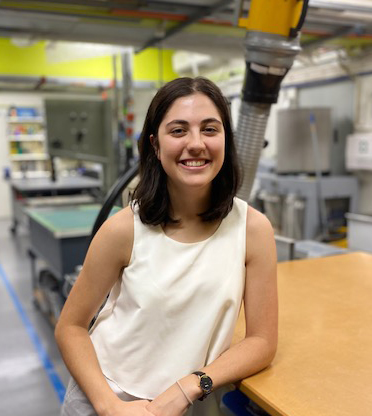What it does
The current mobility aid market is saturated with unaesthetic products that do not address key user needs. The Frankie Chair innovates in this area and solves a range of mobility challenges with one elegant and functional solution.
Your inspiration
In 2020, my family and I had to purchase mobility aids and furniture for my grandparents’ house to assist my Nonno, who was in the early stages of dementia. When looking at day chairs, one thing that stood out to me was how plain, basic and unattractive the existing products are. Nonna was also reluctant to get the chair given it was to sit at her kitchen table but looked like it came straight out of the hospital. After the chair arrived, we quickly noticed a number of mobility challenges that the chair did not solve. This experience showed me that there was a huge gap in the market for mobility furniture to be both functional and aesthetic.
How it works
The Frankie chair has a pressure sensor to help carers monitor wandering for those with dementia. The system uses a conductive plastic sheet that is coded to detect a change in resistance. When the resistance decreases below a certain threshold, a notification is sent to the carer’s phone, signalling that the occupant has left the chair. The Frankie Chair utilises a tilt mechanism which is made up of a series of aluminium linkages. This configuration of parts allows the base of the chair to tilt to a 20 degree incline to help users go from a sitting to standing position. The tilt assist is powered by a battery housed at the back of the chair. To access it, there is a magnetic push hinge that opens the door and the battery slides out on rails for ease of user access. To actuate the tilt, the switch is located underneath the left chair arm; a flick to one side raises the tilt to 20 degrees, and a flick to the other returns it back to a neutral position.
Design process
The process of creating the Frankie Chair began with an extensive literature review. This was followed by market research, developing a business canvas model, researching competitors, surveys, consulting with industry experts and identifying key user needs that the product must address. Followed by ergonomic studies, concept sketching and prototyping. Alongside CAD, buckling and static studies helped to validate the rigidity of parts. Manufacturing costing estimates and design for assembly were important evaluations, including a failure mode and effect analysis and considerations towards its environmental impact. A final prototype was then created of the whole chair. This represented the scale, form and mechanical solutions the Frankie Chair aimed to encompass. Part of the prototyping process included the tilt mechanism. This initially involved exploring two forms of actuation by using cardboard, Lego, ice cream sticks, string, pivot pins and sticky tape. The successful concept (tilt mechanism) was further refined through more iterations of 3D cardboard mock-ups. A laser cut model was then created to simulate the intended tilting motion. A final working prototype was then created with the aluminium linkage system which was more of a production representation of the Frankie Chair.
How it is different
The current offering of mobility products generally aim to solve one user need with each product, rather than one product solving multiple needs whilst also being aesthetic. They are also quite expensive, particularly for something that doesn’t meet a range of customer needs and seem to belong in a hospital setting. This is where the Frankie Chair differs. It addresses a variety of functional considerations into one aesthetic and smart product. The chair offers customisable fabrics with different colour finishes. The touches of wood, contrasting fabric textures, brass fastenings and semi-industrial accents makes the Frankie Chair incomparable to existing designs. The Frankie chair is a stylish piece that would be a welcomed product in any home. Its features prove it to be a viable product for mobility assistance throughout day to day lives, offering a rare blend of elegance and function that is yet to be found in its product sector.
Future plans
I would like to refine the Frankie Chair’s style and execute its function with even more finesse, given the new knowledge I have developed as an engineer since completing this project. After seeing the lack of choice and targeted solutions of products within the mobility product industry, it has definitely opened up a desire to create change within this area. Starting my own company to create these products on my own terms where there is no limit to innovation is an exciting prospect. Creating products that someone would be proud to showcase in their home and assist with day to day lives would be a rewarding path that I would love to go down.
Awards
Outstanding student Achievement Award 2022 within Product Design Engineering at Swinburne University of Technology.



Share this page on